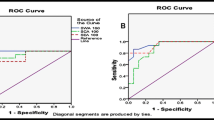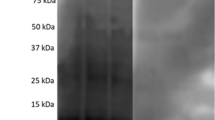Abstract
Schistosoma haematobium soluble egg antigens (SH SEAs) induce intense granulomas in human hosts that often culminate in severe disease. In an attempt to identify the SH SEA fractions that are responsible for pathology, we combined T-cell Western blotting and an in vitro model of granuloma formation. Whole SH SEAs were dotted onto nitrocellulose pieces or were separated by sodium dodecyl sulfate-polyacrylamide gel electrophoresis and electrotransferred onto nitrocellulose paper. Horizontal strips bearing the separated antigens were solubilized in dimethylsulfoxide and precipitated in carbonate/bicarbonate buffer. Antigen-free and antigen-bearing particles were used to stimulate peripheral blood mononuclear cells (PBMCs) obtained fromS. haematobium-infected patients and sex- and agematched healthy controls to form granulomas in vitro. Whole SH SEA-bearing nitrocellulose particles elicited in vitro formation of granulomas by PBMCs from infected donors. The response was similar in sensitivity, specificity, and reproducibility to that evoked by SH SEA-bound polyacrylamide beads. The results obtained in samples from 30 patients and 10 controls tested with SH SEA-separated fractions revealed that SEA bands of 84 000, 63 000, 57 000, 55 000, 40 000, 30 000, and 28 000 Da elicited in vitro granuloma reactions by PBMCs of almost all infected patients. Conversely, separated soluble adult-worm antigens failed to stimulate PBMCs of infected patients to form granulomas. This study is the first to identify the SH SEA fractions that evok in vitro granuloma formation and represents an initial step toward the development of an anti-urinary schistosomiasis pathology vaccine.
Similar content being viewed by others
References
Abou-Zeid C, Filley E, Steele J, Rook GAW (1987) A simple new method for using antigens separated by polyacrylamide electrophoresis to stimulate lymphocytes in vitro after converting bands cut from Western blots info antigen-bearing particles. J Immunol Methods 98:5–10
Bentley AG, Phillips SM, Kaner RJ, Theodorides VJ, Linette GP, Doughty BL (1985) In vitro delayed hypersensitivity granuloma formation: development of an antigen-coated bead model. J Immunol 134:4163–4169
Boros DL (1989) Immunopathology ofSchistosoma mansoni infection. Clin Microbiol Rev 2:250–269
Boros DL, Warren KS (1970) Delayed hypersensitivity-type granuloma formation and dermal reaction induced and elicited by a soluble factor isolated fromSchistosoma mansoni eggs. J Exp Med 132:488–507
Boros DL, Tomford R, Warren KS (1977) Induction of granulomatous and elicitation of cutaneous sensitivity by partially purified SEA of schistosomiasis mansoni. J Immunol 118:373–376
Carter CE, Colley DG (1979) Partial purification and characterization ofSchistosoma mansoni soluble egg antigen with Con-A Sepharose chromatography. J Immunol 122:2204–2209
Domingo EO, Cowan RBT, Warren KS (1967) The inhibition of granuloma formation aroundSchistosoma mansoni eggs: I. Immunosuppressive drugs. Am J Trop Med Hyg 16:248–292
Doughty BL, Phillips SM (1982) Delayed hypersensitivity granuloma formation arundSchistosoma mansoni eggs in vitro: I. Definition of the model. J Immunol 128:30–36
Doughty BL, Ottesen EA, Nash TE, Phillips SM (1984) Delayed hypersensitivity granuloma formation aroundSchistosoma mansoni eggs in vitro: III. Granuloma formation and modulation in human schistosomiasis mansoni. J Immunol 133:993–997
El Ridi R, Abdel Tawab N, Guirguis N (1992)Schistosoma mansoni: identification and protective immunity of adult worm antigens recognized by T lymphocytes of outbred Swiss mice immunized with irradiated cercariae. Exp Parasitol (in press)
Gaafar T, Helmy M, Ismail S, Afifi A, Guirguis N, El Ridi R (1992) Identification of theSchistosoma haematobium soluble egg antigens inducing antibody production and/or T cell proliferation in humans. J Egypt Soc Parasitol 22:441–453
Goes AM, Gazzinelli G, Rocha R, Katz N, Doughty B (1991) Granulomatous hypersensitivity toSchistosoma mansoni egg antigens in human schistosomiasis: III. In vitro granuloma modulation induced by immune complexes. Am J Trop Med Hyg 44:434–443
Hamburger J, Lustigman S, Arap Siongok TK, Ouma JH, Mahmoud AAF (1982) Characterization of a purified glycoprotein fromSchistosoma mansoni eggs: specificity, stability, and the involvement of carbohydrate and peptide moities in its serologic activity. J Immunol 128:1864–1869
Harn DA, Danko K, Quinn JJ, Stadecker MJ (1989)Schistosoma mansoni: the host immune response to egg antigens: I. Partial characterization of cellular and humoral responses to pI fractions of soluble egg antigens. J Immunol 142:2061–2066
Hillyer GV, Pacheco E (1986) Isolation and characterization ofSchistosoma haematobium egg antigens. Am J Trop Med Hyg 35:777–785
Kassis AI, Warren KS, Mahmoud AAF (1978) TheSchistosoma haematobium egg granuloma. Cell Immunol 38:310–318
Lammie PJ, Linette GP, Phillips SM (1985) Characterization ofSchistosoma mansoni antigen-reactive T cell clones that form granulomas in vitro. J Immunol 134:4170–4175
Lukacs NW, Boros DL (1991) Splenic and granuloma T-lymphocyte responses to fractionated soluble egg antigens ofSchistosoma mansoni-infected mice. Infect immun 59:941–948
Lustigman S, Mahmoud AAF, Hamburger J (1985) Glycopeptides in soluble egg antigen ofSchistosoma mansoni: isolation, characterization, and elucidation of their immunochemical and pathological relation to the major egg glycoprotein (MEG). J Immunol 134:1961–1967
Reynolds SR, Kunkel SL, Thoma DW, Higashi GI (1990) T cell clones for antigen selection and lymphokine production in murine schistosomiasis mansoni. J Immunol 144:2757–2762
Smith JH, Christie JD (1986) The pathology ofSchistosoma haematobium infections in humans. Hum Pathol 17:333–345
Sturrock RF (1966) Daily egg output of schistosomes. Trans R Soc Trop Med Hyg 60:139–140
Takacs B (1979) Electrophoresis of proteins in polyacrylamide slab gels. In: Lefkovitz I, Pernis B (eds) Immunological methods. Academic Press, New York, pp 81–105
Towbin H, Staehelin T, Gordon J (1979) Electrophoretic transfer of proteins from acrylamide gels to nitrocellulose sheets: procedure and some applications. Proc Natl Acad Sci USA 76:4350–4354
Von Lichtenberg F (1987) Consequences of infection with schistosomes. In: Rollinson D, Simpson AJG (eds). The biology of schistosomes. Academic Press, London, pp 185–232
Warren KS (1975) Hepatosplenic schistosomiasis mansoni: an immunologic disease. Bull NY Acad Med 51:545–550
Young DB, Lamb JR (1986) T lymphocytes respond to solid-phase antigen: a novel approach to the molecular analysis of cellular immunity. Immunology 59:167–171
Author information
Authors and Affiliations
Rights and permissions
About this article
Cite this article
Gaafar, T., Ismail, S., Helmy, M. et al. Identification ofSchistosoma haematobium soluble egg antigens that elicit human granuloma formation in vitro. Parasitol Res 79, 103–108 (1993). https://doi.org/10.1007/BF00932254
Accepted:
Issue Date:
DOI: https://doi.org/10.1007/BF00932254




